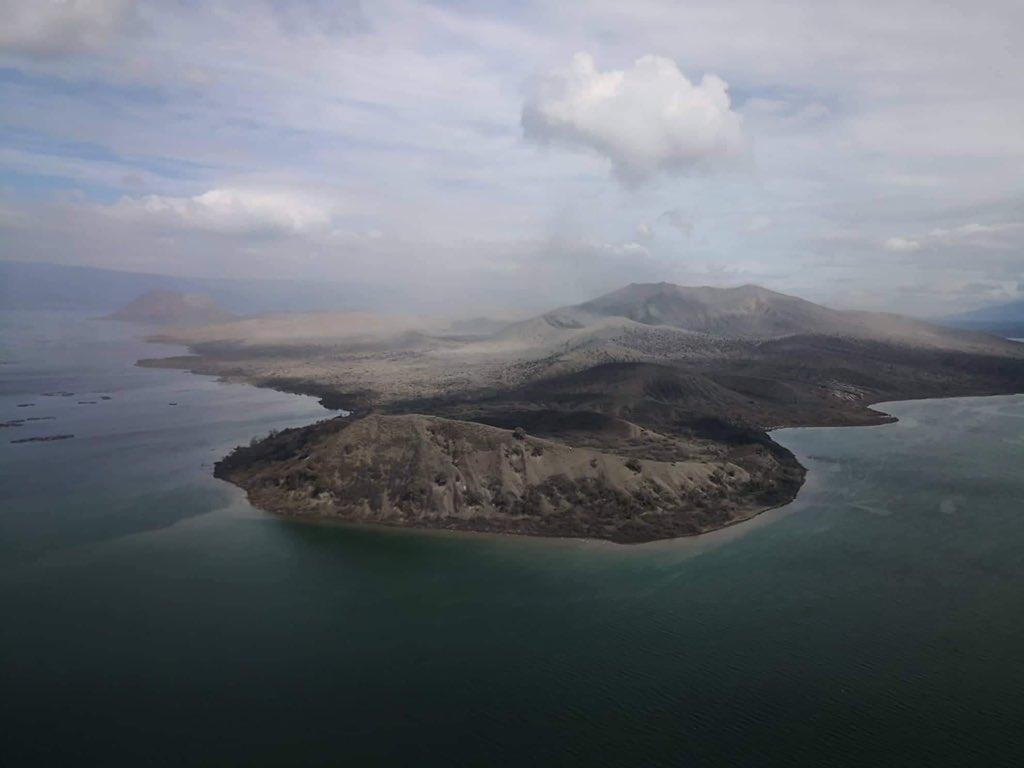Damages on agriculture caused by Taal Volcano’s eruption already cost P4.3 billion across four key industries in Region IV-A (Calabarzon). A record 168,615 people were evacuated to 427 centers in Batangas last Saturday. However, these numbers have since decreased on Thursday after authorities allowed residents to return to their homes for four hours to check on their belongings and feed livestock.
Although reduced activity was observed, scientists are still evaluating whether or not to lower the alert level of the volcano (currently in Alert Level 4, one level away from the highest alert level indicating an explosive eruption).
P1.6 billion were lost in the tilapia and bangus culture in the devastated areas around Taal, making the fisheries industry the most affected sector in agriculture.
The damage on aquaculture
The Bureau of Fisheries and Aquatic Resources (BFAR) reports that at least 2,761 farmers depend on the Taal Lake for livelihood. Noel Reyes, assistant secretary and spokesperson of the Department of Agriculture (DA), said that they are asking other regions to fill in the lack of supply in Metro Manila as 60 percent of their fish comes from Taal Lake. The DA is also gathering support from Cordillera and Nueva Vizcaya to provide food to farmers.
Following the Department of Health’s warning to the public regarding health risks, BFAR said that fish from Taal Lake is safe for consumption as long as it is fresh, caught alive, and thoroughly cleaned. Almost 6,000 fish cage owners of the Taal Lake Aquaculture Alliance, Inc. have appealed to harvest the huge volume of fish they left upon evacuation.
“The economy is about P18 trillion so if you look at the numbers, and in relation to the size of the economy, the impact of agriculture for example is not that large,” Benjamin Diokno said.
BFAR previously announced that 15,000 metric tons of fish are at risk due to the eruption. Once aquaculture operation resumes, the DA will provide tilapia, catfish, carp, ayungin and shrimp fingerlings for livelihood resumption.
A rising threat
The Philippine Institute of Volcanology and Seismology (Phivolcs) confirmed that there is a rise of magma in the volcano, causing deformities in Taal and indicating a possible explosive eruption. Seven hundred fourteen volcanic earthquakes have already been recorded by the Philippine Seismic Network (PSN), 176 of which were at magnitude 1.2 to 4.1 and felt at intensities I to V)
Taal Volcano was reported to be in a calmer state in the past few days, releasing only steady steam emissions and “infrequent weak explosions.” However, volcanic activities underground still pose a threat. Phivolcs director Renato Solidum said that the movement of magma underneath can cause fissures and cracks on the ground, as seen in some areas of Batangas, particularly Lemery, San Nicolas, Agoncillo and Talisay.

Solidum also noted that Taal Volcano is continuously being “uplifted” or stretched (with the most part of it swelling and only the northeastern flank subsiding) and that the crater lake is being vaporized due to volcanic activity. Should a major eruption occur, ash columns higher than five kilometers will pose hazards to Laguna, Metro Manila and some parts of Rizal and Quezon.
THE STATE OF KAPENG BARAKO
Far higher than the DA’s estimated damage cost at P73.95 million, one of Philippine Coffee Board’s directors, Rene Tongson, said that the loss in the coffee industry can reach as high as P1.2 billion (computed based on the current market price of roasted coffee products). Tongson noted that coffee farms may take a year and a half to grow back and fully recover from the damage caused by the eruption.
While P160 million worth of livelihood assistance was distributed among farmers and fisherfolks, P30 million was also set aside for five-years’ loan worth P25,000.
The local demand for coffee is at 135 million kilograms a year, far from the 40 million kilograms that local farmers are currently producing. Ten to 15 percent of the country’s coffee bean harvests come from Batangas and Cavite. Aside from barako, other coffee bean variants produced in Batangas include robusta, excelsa, and arabica.
At this pace, it would take time before the Philippines becomes a coffee exporter again—the numbers only pushing the country to import more coffee, and with the aftermath of Taal’s eruption, there’s a whole coffee industry in need of revival.

With Taal’s unrest and a looming threat of an explosive eruption, there is much to be done to salvage what’s left of agriculture. Five thousand mother coffee plants are pledged by the government for coffee farmers in the area. P1.9 million and 150,000 seedlings and salt fertilizer for damaged trees are allotted by the Philippine Coconut Authority to affected coconut farmers. While P160 million worth of livelihood assistance was distributed among farmers and fisherfolks, P30 million was also set aside for five-years’ loan worth P25,000.
Is there an economic impact?
Despite the significant damage to agriculture, Bangko Sentral ng Pilipinas (BSP) governor Benjamin Diokno said that it won’t affect the economy on a large scale. “The economy is about P18 trillion so if you look at the numbers, and in relation to the size of the economy, the impact of agriculture for example is not that large.”
The BSP predicts the inflation rate for this year and next year to be at 2.9 percent, saying it’s still too early to assess the effect of the devastation on inflation. Diokno also noted the possible decline on real estate areas in Taal.
According to the National Economic and Development Authority (NEDA), there would only be minimal impact to the regional and national economy as well as on its poverty reduction programs. Their initial assessment on the total damages was at P7.63 billion, taking into account a violent eruption from Taal.
The forgone income in the 14-kilometer radius danger zone is not even one percent of the gross regional domestic product of Calabarzon in 2018; the industry and service sector’s estimated forgone income at 0.02 percent and 0.08 percent of the region’s gross value added respectively.

Unless there’s a major explosive eruption, NEDA says there won’t be a significant effect on the economy.
Socioeconomic Planning Undersecretary and NEDA Chief Ernesto Pernia said that the disaster can stimulate the economy through jobs generated by reconstruction and rehabilitation of affected areas. Banking on Batangas and Cavite’s “well-off” provinces status, Pernia said government spending would be substantial and that if anyone was to slide to poverty, it will only be temporary.
Subscribe to our weekly newsletter to receive all the tools and solutions entrepreneurs need to stay updated on the latest news in the industry





